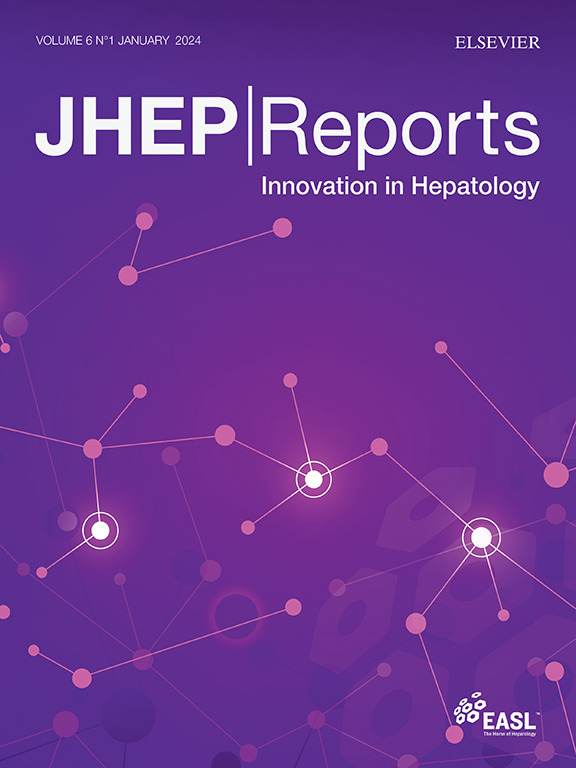促进HCC转移的癌症干细胞样亚群的鉴定
IF 9.5
1区 医学
Q1 GASTROENTEROLOGY & HEPATOLOGY
引用次数: 0
摘要
背景,癌症干细胞(CSCs)是公认的肿瘤发生的驱动因素,但它们在调节肿瘤转移中的作用仍然知之甚少。在这里,我们报告了肝细胞癌(HCC)中一群促进转移的csc样细胞的鉴定和特征。方法通过分析19例HCC样本的单细胞rna测序数据,鉴定HCC中的scsc样细胞。利用9个临床队列的生物信息学分析和实验验证来评估这些细胞的干性和侵袭性特征。12例HCC样本的空间转录组测序揭示了csc样细胞与肿瘤微环境之间的细胞相互作用,并通过基因共表达分析和免疫组织化学验证了这一点。最后,利用信号通路阻断来评估csc样细胞的潜在临床应用。结果通过对19例HCC患者的单细胞rna测序数据和12例HCC患者的空间转录组学数据的综合分析,确定了一个促进转移的csc样亚群。这些csc样细胞表达高水平的上皮-间质转化基因,并与HCC预后不良相关。组织学上,csc样细胞在高侵袭性肿瘤中富集,特别是在肝内弥散性病灶中,它们与免疫细胞相互作用。在功能上,csc样细胞通过ICAM1信号通路诱导巨噬细胞M2极化和T细胞衰竭,形成免疫抑制微环境。在csc样细胞中下调ICAM1表达抑制巨噬细胞m2极化和T细胞衰竭,从而逆转抗肿瘤免疫作用。我们的研究发现了一个促进转移的CSC亚群,为HCC的CSC靶向治疗提供了一个潜在的视角。影响和意义HCC中CSC的异质性已被确定,但促进转移的CSC亚群的鉴定和特征仍未被探索。在这里,我们发现了一个csc样肿瘤细胞亚群,它通过增加细胞侵袭性和抑制ICAM1信号通路的抗肿瘤免疫反应来促进HCC转移。我们的研究从CSCs的角度揭示了肝癌转移的新机制,并提出了抑制CSCs样细胞与免疫细胞相互作用的潜在肿瘤治疗策略。本文章由计算机程序翻译,如有差异,请以英文原文为准。

Identification of a cancer stem cell-like subpopulation that promotes HCC metastasis
Background & Aims
Cancer stem cells (CSCs) are well-established drivers of tumorigenesis, but their role in regulating tumor metastasis remains poorly understood. Here, we report the identification and characterization of a cluster of metastasis-promoting CSC-like cells in hepatocellular carcinoma (HCC).
Methods
CSC-like cells in HCC were identified through the analysis of single cell RNA-sequencing data from 19 HCC samples. The stemness and invasive characteristics of these cells were evaluated using bioinformatical analyses of nine clinical cohorts and experimental validations. Spatial transcriptomics sequencing of 12 HCC samples revealed the cellular interactions between the CSC-like cells and tumor microenvironments, which were validated through gene co-expression analyses and immunohistochemistry. Finally, signaling pathway blockade was used to assess the potential clinical application of CSC-like cells.
Results
Through comprehensive analyses of single cell RNA-sequencing data from 19 patients with HCC and spatial transcriptomics data from 12 patients with HCC, a metastasis-promoting CSC-like subpopulation was identified. These CSC-like cells expressed high levels of epithelial–mesenchymal transition genes and were associated with poor prognosis of HCC. Histologically, CSC-like cells were enriched in highly aggressive tumors, especially in intrahepatic disseminated foci, where they interacted with immune cells. Functionally, CSC-like cells induced macrophage M2 polarization and T cell exhaustion through the ICAM1 signaling pathway, forming immunosuppressive microenvironments. Downregulation of ICAM1 expression in CSC-like cells suppressed macrophage M2-polarization and T cell exhaustion, thereby reversing antitumor immune effects.
Conclusions
Our study identified a metastasis-promoting CSC subpopulation, providing a potential perspective for CSC-targeted therapies in HCC.
Impact and implications
The heterogeneity of CSCs in HCC has been identified, yet the identification and characterization of metastasis-promoting CSC subpopulations remain unexplored. Here, we identified a CSC-like tumor cell subpopulation that promotes HCC metastasis by increasing cell invasiveness and suppressing antitumor immune responses via the ICAM1 signaling pathway. Our study uncovers novel mechanisms of HCC metastasis from the perspective of CSCs, and proposes potential tumor therapeutic strategies by inhibiting cellular interactions between CSC-like cells and immune cells.
求助全文
通过发布文献求助,成功后即可免费获取论文全文。
去求助
来源期刊

JHEP Reports
GASTROENTEROLOGY & HEPATOLOGY-
CiteScore
12.40
自引率
2.40%
发文量
161
审稿时长
36 days
期刊介绍:
JHEP Reports is an open access journal that is affiliated with the European Association for the Study of the Liver (EASL). It serves as a companion journal to the highly respected Journal of Hepatology.
The primary objective of JHEP Reports is to publish original papers and reviews that contribute to the advancement of knowledge in the field of liver diseases. The journal covers a wide range of topics, including basic, translational, and clinical research. It also focuses on global issues in hepatology, with particular emphasis on areas such as clinical trials, novel diagnostics, precision medicine and therapeutics, cancer research, cellular and molecular studies, artificial intelligence, microbiome research, epidemiology, and cutting-edge technologies.
In summary, JHEP Reports is dedicated to promoting scientific discoveries and innovations in liver diseases through the publication of high-quality research papers and reviews covering various aspects of hepatology.
 求助内容:
求助内容: 应助结果提醒方式:
应助结果提醒方式:


